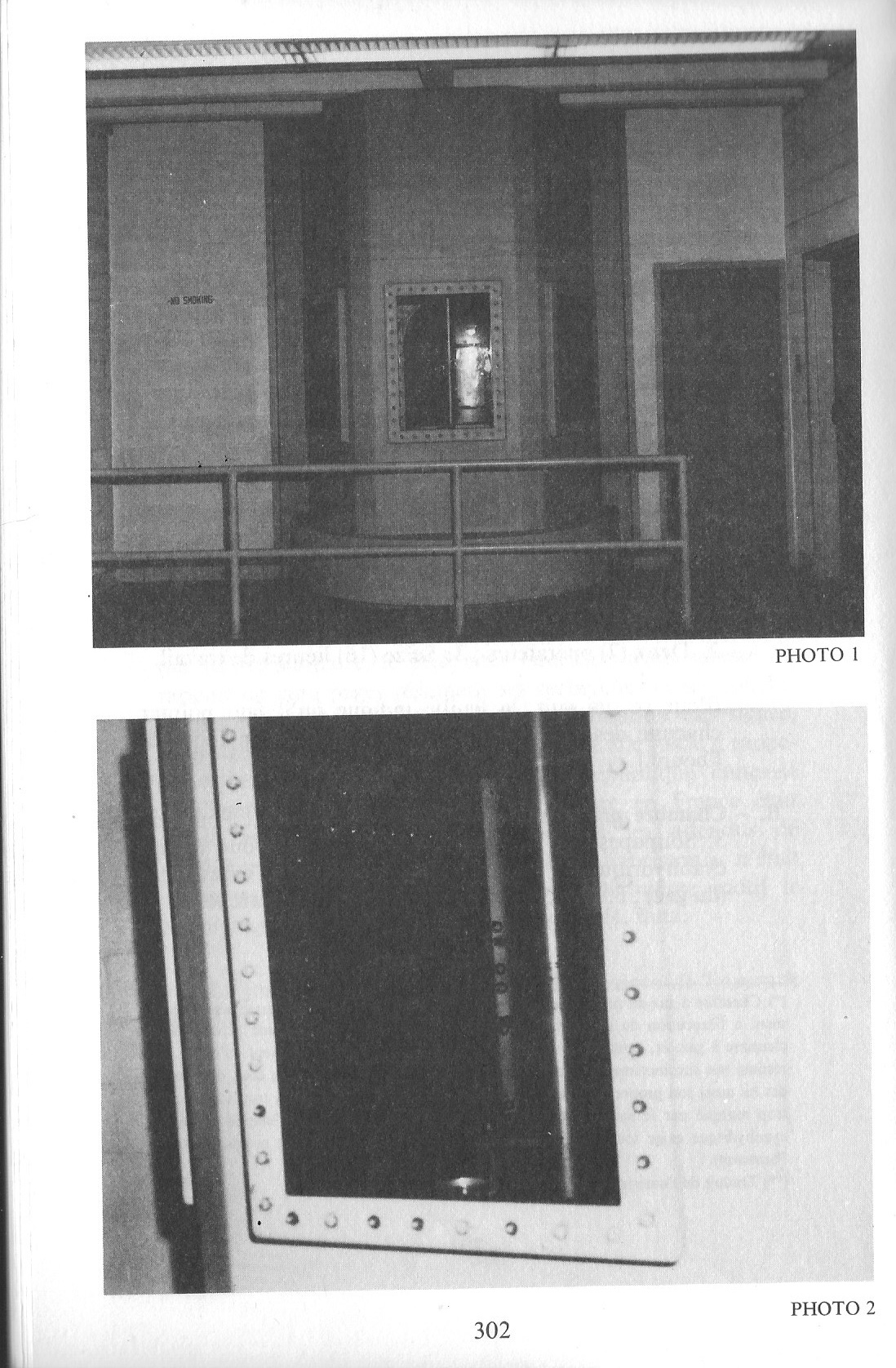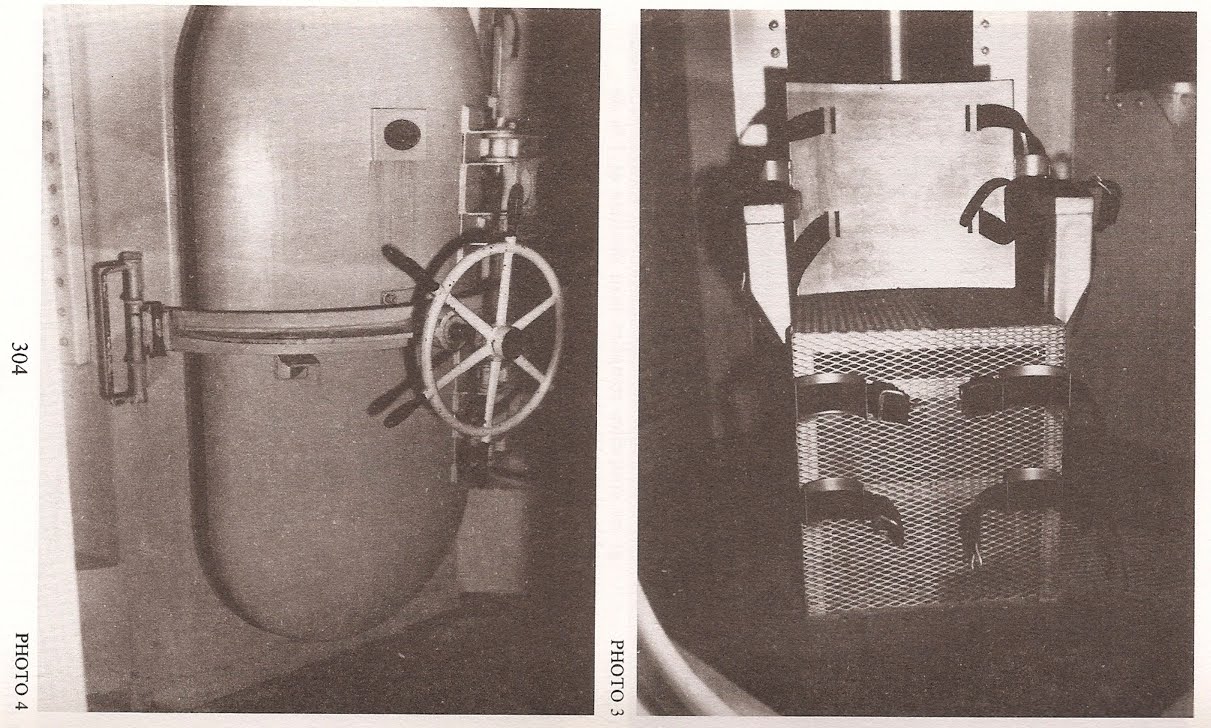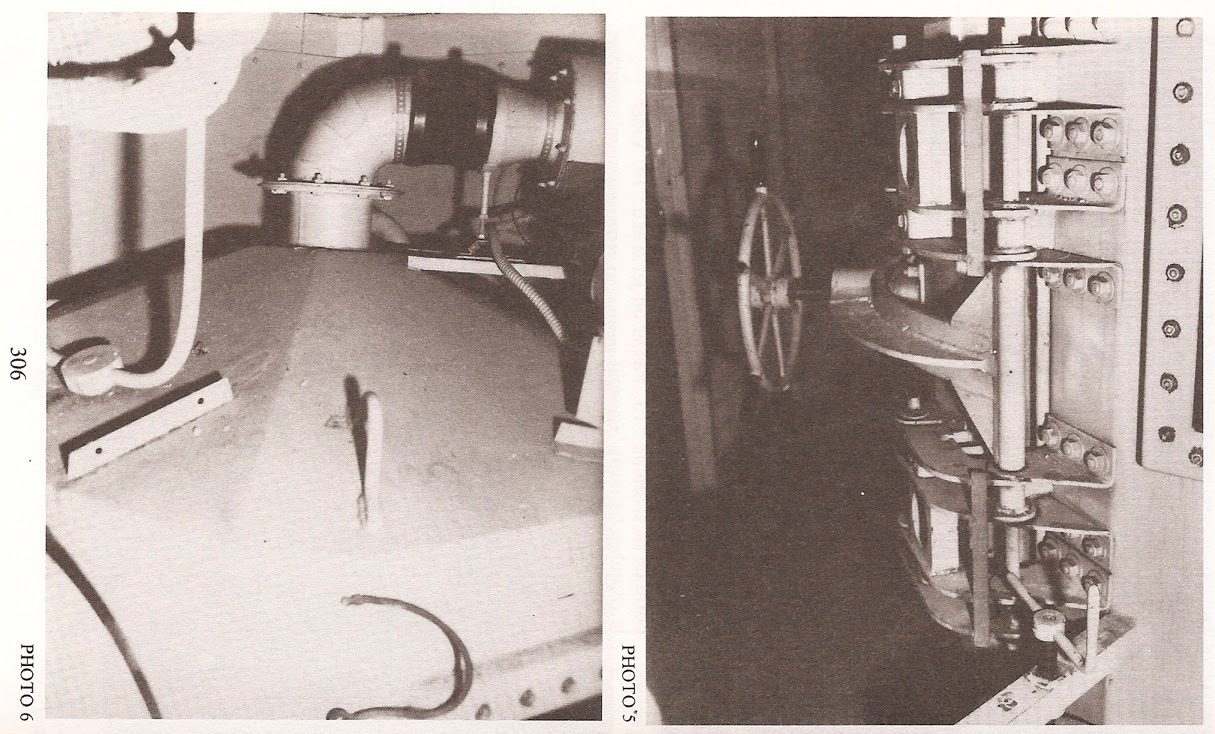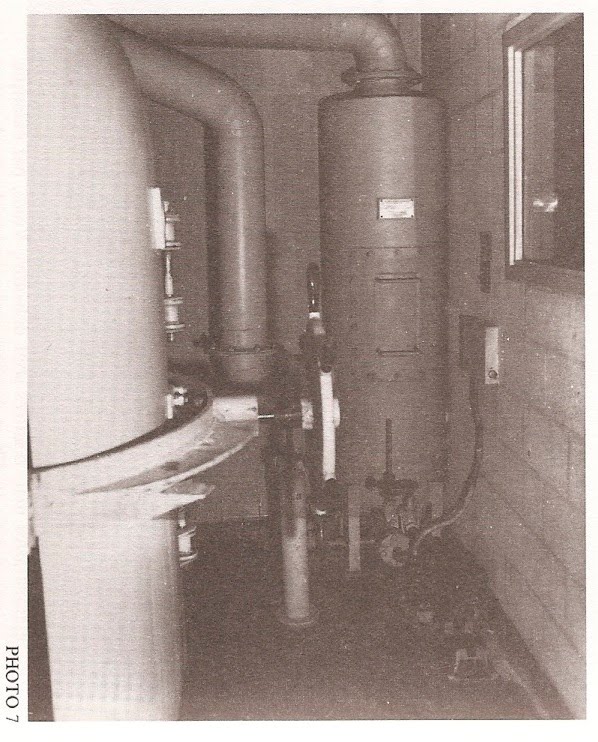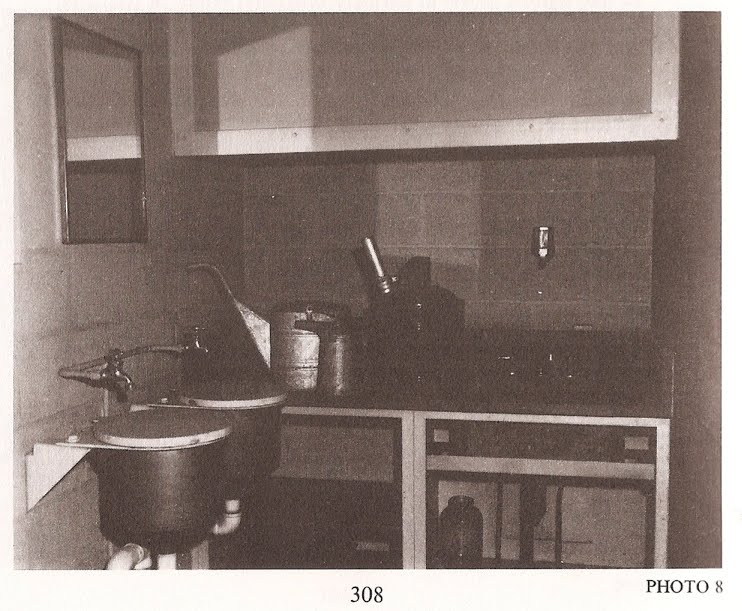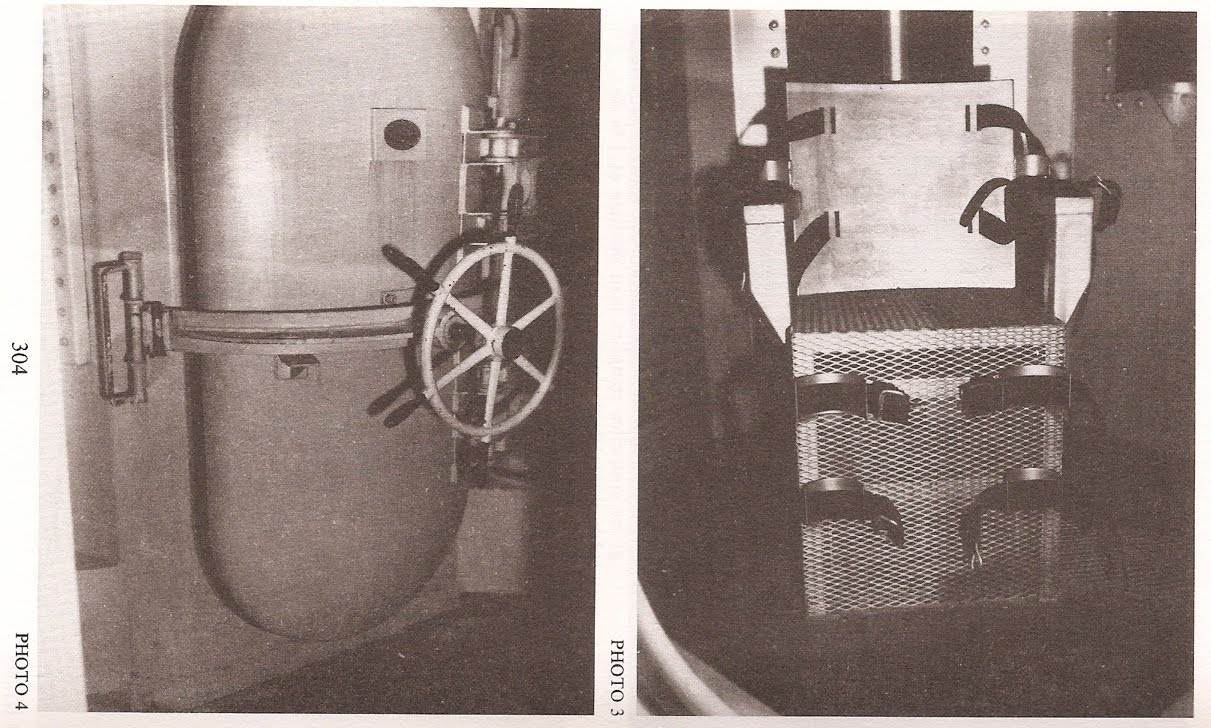Gas chamber of the Maryland State Penitentiary, Baltimore (USA)*
GAS CHAMBER PROCEDURE CHECK SHEET
(CHECK) (TIME)
A. To Ready Chamber:
- Two (2) Days
- Two (2) Officers
- Sixteen (16) Working Hours
B. Chamber Readied:
- Seals ( ) ( )
- Pumps ( ) ( )
- Valves ( ) ( )
- Scrubber ( ) ( )
- Exhaust System ( ) ( )
- Above in Operating Condition ( ) ( )
C. Preparatory Steps:
- Ammonia Tank Hook-Up ( ) ( )
- Scrubber Chemical Mixed (7 lbs. caustic soda to 15 gallons of water) ( ) ( )
- Scrubber Loaded ( ) ( )
- Scrubber Motor Running ( ) ( )
- Mixed Acid and Water for Generator (3 qts Sul. Acid, 5 qts Water) ( ) ( )
- Mix and Hold Caustic Solution in Bucket ( ) ( )
- Check and Have Cyanide Ready ( ) ( )
- Check Position of:
- Drop Lever, No. 1 (Should be closed) ( ) ( )
- Fresh Air Intake, No. 2 (Should be closed) ( ) ( )
- Intake From Acid Mixing. No. 3 (Should be closed) ( ) ( )
- Drain Valve Pot From Generator, No. 4 (Closed) ( ) ( )
- Scrubber Pipe, No. 5 (Should be closed) ( ) ( )
- Ammonia Valve on Tank (Should be closed) ( ) ( )
- Beakers Filled (Distilled Water and 1% Phenolphtalein ( ) ( )
- Scrubber Pump Motor Running ( ) ( )
- Chamber Exhaust Fan Running ( ) ( )
D. Execution Steps:
- Man Placed and Strapped in Chair ( ) ( )
- EKG Leads Applied ( ) ( )
- Cyanide Placed on Top of Closed Generator ( ) ( )
- Chamber Sealed ( ) ( )
- Chamber Vacuum Checked (Should be 1.5”) ( ) ( )
- Intake Valve No. 3, from Acid Mixing Pot, Opened ( ) ( )
- Interval for Acid in and Report from Chemical Room ( ) ( )
- Intake Valve No. 3 Closed ( ) ( )
- Safety Bucket – Caustic Soda into Acid and Mixing Pot ( ) ( )
- Drop Lever No. 1 Opened and Jarred effecting dropping of Cyanide into Acid ( ) ( )
- Gas Generated – Execution Effected ( ) ( )
E. Clearing Chamber:
-
Open No. 5 Valve (Scrubber Pipe) ( ) ( )
-
Allow twenty (20) minute interval (Gas being discharged through Scrubber) ( ) ( )
-
Safety Mixture Emptied Into Gas Generator by Opening No. 3 Valve ( ) ( )
-
Open No. 4 Valve (Exhaust from Gas Generator and Clear Water Running from Acid Mixing Pot through Gas Generator exhausted into Sewer when No. 4 Valve opened) ( ) ( )
- Stop Recirculating Fan ( ) ( )
- Ammonia Valve, No. 4, Open to Four (4) Pound Pressure. (Permit Ammonia to run two (2) minutes) ( ) ( )
- Close Ammonia Valve, No. 4 ( ) ( )
- Beaker Should Indicate Ammonia Content (Should change from pink to purple to show circulation) ( ) ( )
- Crack No. 2 Valve (Fresh Air Intake – Only Air into Chamber ( ) ( )
- Gradually Open No. 2 Valve (Take two (2) minutes to open completely) ( ) ( )
- Allow No. 2 Valve to remain Open from twenty (20) to thirty (30) minutes ( ) ( )
- Open Chamber Door ( ) ( )
- Hose Down ( ) ( )
- Empty Chamber (Body Removed) ( ) ( )
July 15, 1958, revised October 22, 1975, SHE: fh.
[Copied from the paper received from Lieutenant Walter Farrier on September 14, 1979]
Remarks on this document
I visited this gas chamber in September 1979 and had its operation explained to me. The prison officials told me that “gassing a man is very complicated, because it’s dangerous”. Today’s gas chambers do not differ essentially from the gas chambers developed in 1936-1938 after years of trial and error. The first Americans who had the idea of this manner of execution had thought that nothing would be easier and more humane than lulling their condemned prisoners to sleep with a gas that would eventually kill them. It was when they sought to put their idea into action that they realised the formidable difficulties of such an execution. The first one took place in 1924 and presented such dangers for those in the immediate vicinity that the idea of gassing was nearly abandoned. The document above is a simple check sheet for forty-seven steps. Some of these are elementary but others are quite delicate. Here, for example, is what the forty-seventh and final step (emptying the chamber, removing the body) entails: the physician and two assistants must enter the chamber wearing gas masks, rubber aprons, rubber gloves; the physician tussles the dead man’s hair in order to disperse as much as possible the hydrogen cyanide molecules that the ammonia fumes and the adjustable ventilator system have not been able to neutralise; the two assistants must wash the body with a spray hose; they must take great care in doing this work; they must, in particular, wash out the mouth and all other openings of the body, and must especially not overlook the folds of the arms and legs.
Indeed, gassing someone nearby without gassing oneself is no soft job. Most likely the tales of gassings at Auschwitz were, originally, nothing but ghastly prison rumours.
February 11, 1980
_________________________
* Directly participating in the execution of the condemned man are a physician, installed in a booth near the gas chamber, and, in another booth, two operators. The document shown here summarises very succinctly the operators’ work. The physician, for his part, must also have his own summary to hand. Is all this not too complicated, too sophisticated, too marked by a desire of perfection? The answer is no. The use of hydrogen cyanide requires all of these precautions. It is impossible to do any less without risking the lives of personnel.
[Published in French in Serge Thion, Vérité Historique ou Vérité Politique?, La Vieille Taupe, Paris 1980, p. 301-307, with the eight photographs reproduced below]
